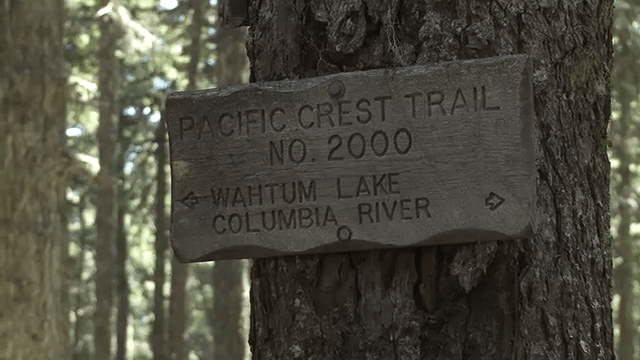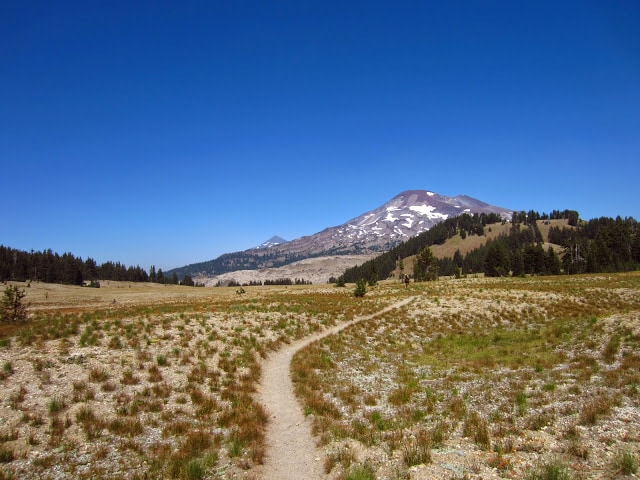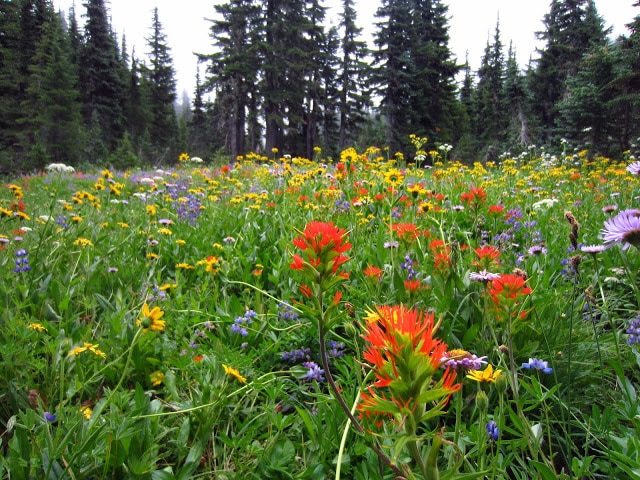Despite warm summer-like temperatures, some of Oregon’s most prized mountain wilderness areas are just waking up from winter. In the Mark O Hatfield Wilderness – prized for silence, solitude and stunning scenery – you won’t hear phones, radios or TV.
Yet each spring, you may hear the unique raspy tones of cross-cut saws at work across a large tree that fell across the trail. It is the sound of trail-keepers who give their time and labor so hikers and campers have an easier way. They are volunteers with the Pacific Crest Trail Association who move the trees that fall across the PCT each winter.
“Often, one tree will often come down from wind or snowfall and it hits another,” said crew leader David Roe. “And that hits another and then another, so we frequently find jumbles of trees – like a jigsaw puzzle – that must be taken apart and moved off the trail.”
This section of the PCT runs through a designated wilderness so mechanized tools like chain saws are not allowed. The crew uses only hand tools, like axes, brush saws and century-old cross-cut saws to do the work. Justin Popov said the large two handled cross cut saws require teamwork: “There is a rhythm as you work with another person; kind of a push-pull back and forth. It’s kind of an endurance thing, so we stay slow and steady. Eventually, you make your way through the log.”
The Mt Hood Chapter of the PCTA is all-volunteer and nearly a thousand strong according to Kathleen Walker, USFS Recreation Manager, who said the agency couldn’t do the work without them: “We have more than 250 miles of trail on the Mt Hood National Forest and if they weren’t out here, we wouldn’t be able to get to even half of that. The most amazing thing about these folks is that they’ve taken a huge leadership role in trail maintenance and volunteerism across the forest too.”
The PCTA volunteers provide their own gear, pay their own expenses and must complete specialized training in order to handle the tools. For example, “Sawyer” training is a rigorous series of sessions – often led by Roe – that prepares the volunteers to meet the same standards as US Forest Service employees. The cross-cut saws are from a bygone era; manufacturers stopped producing them after World War II. So, Roe and others scour the countryside including old barns, attics or even atop fireplace mantles.
Roe said, “The old saws often ended up hanging on a wall and now, after all these years, we’re putting them back to use on the trail. We keep a tradition alive by maintaining and using these. In another generation they’d probably fade from memory.”
Tyler Marriott has been a volunteer the past 8 years and said that he fell in love with the outdoors coupled with the lost art of using cross-cut saws. “It is more exercise, more work but it’s cool, just so cool to be out there doing something useful for others besides sitting behind a computer all the time.”
Back out on the PCT in the Hatfield Wilderness Area, Roe said they are always looking for new recruits and on this trip, they found a good one in Dorothy Brown-Kwaiser. She was learning how to handle a cross-cut saw and was making good progress. “It is amazing to think that 2,661 miles of PCT is maintained just like this,” said Brown-Kwaiser. “And all the work is done by volunteers across the entire Pacific Northwest – it’s unbelievable really!”
Dorothy should know – she trekked the entire PCT in 2012. The trail stretches from the US-Mexico border to the US-Canada border and it was established in 1968. She called the Oregon portion of the PCT, all 457 miles of it, “simply splendid.”
“We stayed in some beautiful wilderness areas in Oregon where the wildflowers are stunning near peaceful alpine lakes – it’s just beautiful! Hiking the PCT is one of those things in your life that gives a lot of peace of mind.”
Dorothy admitted she gained new confidence and found plenty of peace on her five-month hike and now it is time for her to give back. “By working on this trail I can help to give people the experience that I had on my trek. I want to give back so other people can enjoy our wonderful wilderness.”
Roe added that while the work is hard, it is a soul-satisfying reward to provide a service. “I really don’t think we’d get volunteers out here to do this if it wasn’t a rewarding and fulfilling job.”
The Pacific Crest Trail Association is always on the lookout for more volunteers who enjoy Oregon’s wilderness areas and want to continue the service of keeping the trail and tradition alive.



